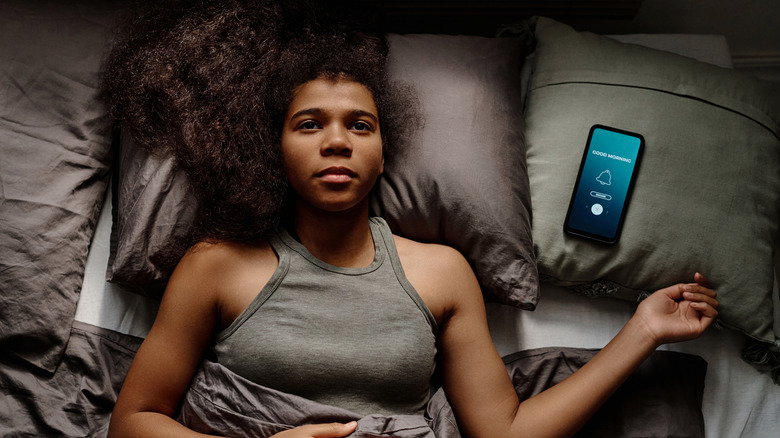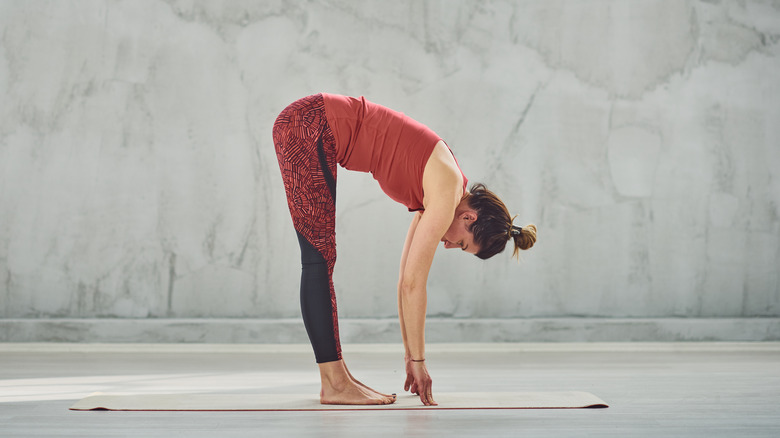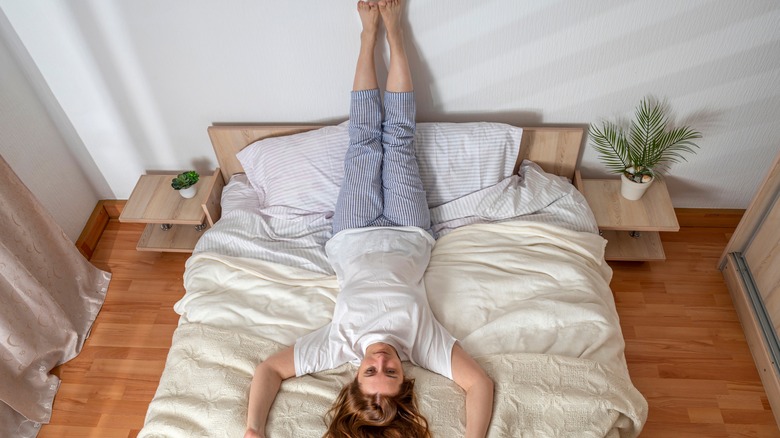The Easy Exercise You Can Do Before Bed To Reduce Stress And Help You Sleep
Exercise is one of the most important tools for losing weight when combined with a healthy diet. Whether you start your day with a brisk walk or end your day with high-intensity interval training (HIIT), moving your body every day helps you burn more calories. Some types of exercise, like HIIT and circuit training, create an afterburn, which means you'll continue to burn more calories as your body recovers.
Dr. Chris Mohr, a fitness and nutrition advisor for Fortune Recommends, tells Health Digest that vigorous exercises that jack up your heart rate aren't the wisest choice before bed. "I recommend gentle, relaxing yoga poses at bedtime to avoid energizing your body too much before sleep," he said.
One easy exercise you can do before bed is a forward fold. "This pose, also known as Uttanasana, calms the mind and reduces stress, which is needed for good sleep," he said. "As for burning calories, while the pose itself doesn't burn many calories, practicing yoga can slightly increase your metabolic rate due to natural body processes during sleep." Stress and a lack of sleep could frustrate your weight loss efforts, so yoga poses like the forward fold could help.
The role of stress and sleep on weight loss
Life stressors such as relationship problems, financial difficulties, work demands, or losing a loved one not only harm your mental health but also your physical health, according to a 2017 article in Obesity Reviews. Stress can cause you to gain weight in your midsection, which can increase your risk of chronic conditions like heart disease and cancer. Stress can also make it more difficult to sleep, and a lack of sleep can increase your cravings and cause you to eat more. Improving your sleep quality is linked to better weight loss, particularly in reducing harmful belly fat.
"Yoga before bed is often promoted for its ability to calm the mind and relax the body," Mike Masi, a physical therapist with Garage Gym Reviews, said in an interview with Health Digest. "The connection to better sleep is likely related to a stimulation of the parasympathetic nervous system, but the idea that this routine will have any direct effects on metabolism is dubious." In other words, a forward fold won't burn calories, but it can signal to your body that it's time to wind down as part of your bedtime ritual.
How to do a forward fold to reduce stress before bedtime
Dr. Chris Mohr suggests creating a soothing environment before bedtime, starting by shutting off electronics and anything that could stimulate your sympathetic nervous system. Getting a good night's sleep also requires consistency so your body and mind can align to a sleep schedule. A forward fold doesn't require yoga pants or a yoga mat, so feel free to get into your pajamas.
Begin by taking slow, deep breaths through your nose, making sure your belly and ribs expand on every exhale and contract on each exhale. If diaphragmatic breathing is new to you, place your hands just below your ribs with the middle fingers lightly touching. On the inhale, try to breathe so your diaphragm pushes your belly out. Your fingers should spread apart by a few inches. Work on extending the exhale longer than the inhale without sacrificing the depth of each inhale.
Stand with your feet at a comfortable distance apart with your knees slightly bent. Drop your chin to your chest, then slowly roll forward one vertebra at a time while your arms hang loosely from your shoulders. Once you feel a slight stretch in your back and hamstrings, rest your hands on your shins or the floor, bending your knees as much as necessary. Avoid straining yourself in the stretch to the point of pain. Keep breathing deep, and hold the pose for about five minutes. To come out of the pose, roll up one vertebra at a time.
Other yoga poses to do before bed
If physical limitations like a foot injury don't permit a standing forward fold, you can practice Paschimottanasana, a seated forward fold. For this pose, it's a good idea to elevate your hips on a pillow or a folded blanket so you don't strain your lower back. A seated forward fold begins with slightly bent knees, and your legs can be close together or as wide as comfortable. Roll forward so your belly touches your thighs, using your hands on the floor to serve as brakes so you don't strain too far. Once you feel a delicate stretch (not too much), hold that stretch for five minutes. You might notice your body melting deeper into the pose as your tissues soften. Don't worry about getting your head to reach your legs — your forward fold might be a slight lean at first.
Mike Masi suggests a slow vinyasa flow where you simply transition from an easy cobra pose to a child's pose to relieve lower back pain. You can also try moving between reclined cobbler's (butterfly) pose and happy baby pose to give your hips some stretch. Inversions like legs on the wall (viparita karani) drain excess fluid from your legs and reduce stress to help you sleep.



